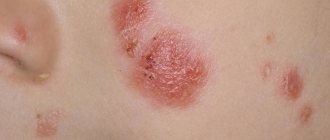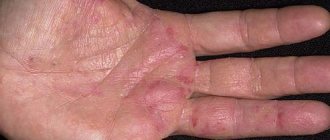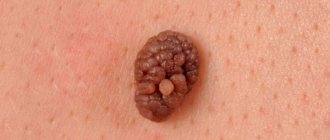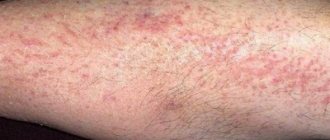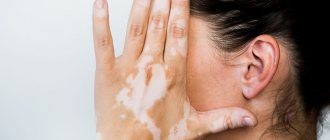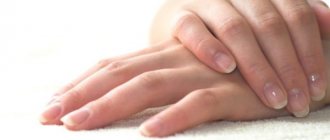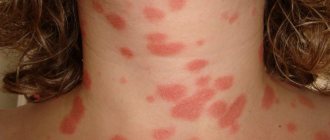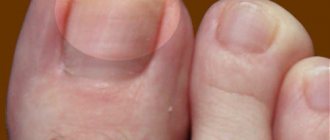Psoriatic skin lesions can develop in any person, regardless of gender, age and nature of work activity. Most often, the first symptoms of this disease appear in the age range from 15 to 25 years. Below we will discuss the symptoms and treatment of psoriasis on the hands, feet, head and nails, and will also give recommendations for preventing relapses of psoriatic disease.
Causes of psoriasis on the hands
Among the key causes of the disease are:
- genetic predisposition;
- disturbances in the functioning of the immune mechanism;
- endocrine problems;
- hormonal imbalances;
- diabetes;
- past viral and infectious diseases;
- metabolic problems; prolonged or severe stress;
- regular contact with harmful chemical elements (including those found in cosmetics);
- skin injury.
Psoriasis can also be caused by poor diet, alcohol and cigarette abuse, and a long course of strong medications (for example, antidepressants and steroids).
The risk group includes people with a tendency to allergic reactions.
With psoriasis on the hands, the causes and treatment are closely interrelated, photos of the variety of manifestations of this disease are proof of this.
Find out more
Disease prognosis
An unpleasant psoriatic rash on the hands causes stress for many patients. At the same time, worries only worsen the situation. Psoriasis can be in the regression stage for a long time, but for this you need to follow the therapeutic and preventive measures prescribed by your doctor.
It is impossible to completely get rid of psoriasis, but proper skin care, following a diet and using special creams will hide the symptoms of the disease as much as possible. Regardless of the manifestations of the disease, it is recommended to visit a dermatologist every few months to monitor the dynamics of the disease and adjust the treatment regimen if the condition requires it.
Stages of psoriasis on the hands
Since this disease is chronic, it has a certain progression.
In total, there are three key stages in the development of pathology:
- Progressive or initial. Several reddish spots form on the hands, shoulders, between the fingers or in the fold areas. They are accompanied by peeling, swelling of the skin and intense itching. Gradually the number of formations increases. Photos of the symptoms clearly demonstrate how psoriasis begins on the hands.
- Stationary. No other formations are formed, and existing ones are covered with silvery scales, which are easy to remove. The itching is either significantly reduced or goes away completely.
- Regression stage. External manifestations weaken and gradually disappear. Sometimes pigmentation may appear at the site of the rash.
With each new exacerbation, all three stages are repeated. You can see what psoriasis looks like on your hands in the photo.
The disease may not make itself felt from 2 months to several years.
Subtypes of psoriasis on the hands
Hand skin psoriasis has four main types:
- Pustular form. Usually localized on the forearms and palms. The formations have the form of small reddish spots with purulent content. They are called pustules. Pustules can merge with each other to form larger formations. This subtype is considered one of the most dangerous varieties, since it can lead to complications in the form of severe swelling of the palms and the development of nephropathy.
- Drop-shaped. Usually the rash appears on the upper areas of the arm, in the shoulder area. The outlines of the formations resemble drops.
- Plaque form. Or classic. Reddish plaques appear on the skin, sometimes merging with each other.
- Nail psoriasis. Vertical or transverse lines of a light shade are formed on the plate. The skin around the nail becomes thicker and denser. Over time, the nail plate is destroyed. Treatment for fingernail psoriasis is usually no different than usual.
Among other things, psoriatic lesions are classified by location. It can affect the shoulders and forearms, palms and back of the hands, fingers, interdigital area and nails. For different types of psoriasis, photos of symptoms on your hands will help you understand the differences.
Psoriasis on the hands. Symptoms
Regardless of the subtype of the disease, psoriasis has common common symptoms:
- small or medium-sized spots that slightly rise above the skin (with psoriasis on the hands, photos of the initial stages clearly demonstrate the features of the spots);
- tendency of spots to merge with each other;
- red or pinkish undertone of formations;
- hyperemia of the skin;
- peeling of the skin and the appearance of silvery scales on top of the rash;
- cracking of the epidermis;
- itching or burning;
- joint pain;
- dry skin.
If the disease affects the nails, their color and structure change. In this case, photos of the symptoms of psoriasis on the hands and treatment can be found on the Internet.
If the formations are damaged, painful ulcers may form in their place. Often the patient experiences internal discomfort.
Cosmetical tools
Methotrexate
An antimetabolite agent with antitumor and cytostatic effects. The drug has the ability to regulate the rate of cell mitosis. Methotrexate is used for cancer, severe forms of psoriasis, rheumatoid arthritis, lymphoblastic leukemia and other pathologies. The use of the product is allowed only as prescribed by a doctor.
Diprospan
A hormonal drug produced in the form of an injection solution. Its action is aimed at eliminating the inflammatory process, inhibiting the process of cell division, eliminating pain, and restoring the skin.
The remedy is indicated for rheumatoid arthritis, systemic allergic diseases, skin diseases, pathologies of the kidneys and digestive tract. The drug is prohibited among patients suffering from high blood pressure, viral and purulent infections, gastric and duodenal ulcers, tuberculosis, nervous disorders and other diseases.
Neotigazon
A systemic retinoid available in tablet form. The drug has an antiseptic, regenerating, anti-inflammatory, healing effect. Retinoic acid in its composition helps regulate the process of cell division and ensures its keratolytic effect.
Folic acid
69% of patients with psoriasis report a decrease in the effectiveness of traditional therapies with long-term use. The cardinal solution in this situation is the use of hormonal compounds for external therapy. Creams and ointments based on glucocorticosteroids quickly eliminate stains, but such compositions can be applied for no more than 10 days.
Important! Hormonal ointments and creams have a wide list of contraindications and side effects. If the treatment regimen is violated, intoxication is possible. Before use, consult a dermatologist.
Preparations based on glucocorticosteroid components are:
- Flumethasone. After use, a high efficiency coefficient is noted, it helps to get rid of rashes and plaques once and for all, heals cracks and deeply moisturizes the skin.
- Hydrocortisone 1%. The drug effectively eliminates all skin imperfections and has a fast-healing effect. After a week of treatment, patients note skin cleansing by 90% or more.
- Budesonide. Cream based on prednisolone corticosteroids. It is with the help of non-traditional glucocorticosteroid drugs that the symptoms of psoriasis can be quickly eliminated.
The use of hormonal drugs is aimed at eliminating the symptoms of the disease, and not at masking them. And only competent treatment can completely clear the skin of unpleasant rashes.
On the Internet you can find many reviews about folk methods of combating age spots after psoriasis. Such methods allow you to quickly remove stains, but there is always a risk of side effects. The most popular means are:
- Soda solution. To prepare it, you need to mix two tablespoons of baking soda with a small amount of water until a creamy mass is obtained. The composition should be applied to age spots for 10 minutes, then rinsed off with warm water. You can smear the skin with this composition no more than 2 times a week.
- Birch tar. Apply a thin layer of tar to age spots and leave for 10-15 minutes. After which the tar should be washed off with warm water, and problem areas of the skin after the procedure can be wiped with infusion of celandine.
- Sunbathing. Ultraviolet irradiation helps even out the color of the skin and eliminate rashes, but patients with psoriasis must use protective creams and ointments. This method of removing stains is contraindicated in patients with the summer form of the disease.
It should be emphasized that such methods of combating the residual effects of psoriasis are a risky decision. You should not rely on reviews of unknown people and place high hopes on alternative medicine methods, but you can use folk remedies under the supervision of a doctor.
Treatment of psoriasis on the hands
For psoriasis on the hands, treatment is carried out comprehensively, combining several measures at once. Among them:
- Local medications. Ointments or creams containing active ingredients. Previously, cytostatics and hormone-containing compounds were used. Now preference is given to retinoids and all kinds of sedatives. The main tasks of local preparations are to exfoliate dead skin particles, eliminate swelling and inflammation, and relieve redness and itching. The products are actively used for psoriasis on the hands at the initial stage.
- Systemic medications. Products for internal use. Affects the immune system and inflammatory processes. They are used less frequently - in advanced cases or when local therapy does not produce the desired results.
- Physiotherapy. Procedures such as laser exposure, PUVA therapy, cryo- and ozone therapy, bioresonance therapy and ultraviolet irradiation are used. There are photos of psoriasis on the hands before and after physiotherapy.
- Diet. It is of an eliminative nature. Potential allergens and harmful foods such as sweets and smoked foods are removed from the diet. Ideally, the menu is drawn up by the attending physician.
Treatment is usually self-administered with periodic hospital visits. However, if the disease is severe, the patient may be transferred to a hospital.
Treatment of psoriasis on the hands. Help with folk remedies
It is better to resort to traditional methods only in the first stages of the disease. In the case of psoriasis, photographs of the initial stage on the hands can be found in abundance on the Internet.
Home remedies include the following recipes:
- Herbal collection. Chamomile flowers, St. John's wort, parts of yarrow, calendula flowers, string and leaves of celandine are taken in equal parts. Mix everything and pour boiling water over it. Afterwards, the composition is kept in a water bath for 20-30 minutes and cooled. The decoction is used as lotions, compresses and baths. It can also be taken orally - 50 ml three times a day. Plants relieve inflammation, relieve itching and help improve metabolism.
- Egg ointment. Take the yolks of boiled eggs and place them in a frying pan over low gas. The yolks should become oily. They are then allowed to cool and applied to the rash areas for 15-20 minutes. Rinse off with lukewarm water. You can replace it with a decoction of herbs.
- Propolis ointment. Take 200 grams of pork fat and 100 grams of propolis. The ingredients are placed in the oven to completely melt. Then take everything out and mix it with two tablespoons of sea buckthorn oil. The cooled mixture is applied to the affected areas up to 6 times a day. The course is until the skin becomes clear.
It is worth remembering that before using any of the folk recipes you should consult a doctor. Otherwise, side effects may occur.
Treatment of psoriasis on the hands with medications
Hand psoriasis is treated with the following categories of medications:
- Soothing and moisturizing creams. As well as gels and ointments. They soften the skin of the hands, prevent the formation of cracks and alleviate symptoms.
- Anti-inflammatory ointments. Increases local skin immunity and stops inflammation processes.
- Antibacterial ointments. Additional means that prevent infection from entering the body.
- Antihistamines. Local or systemic use. They weaken the immune response and fight inflammation.
- Corticosteroids. Hormonal drugs. Indicated in severe and advanced cases. May be in the form of ointment or tablets.
- Hepatoprotectors. Medicines to support liver function.
- Sorbents. Cleanse the body of poisons and toxic substances, including potential allergens.
- Immunomodulators. Needed to harmonize the functioning of the immune system.
- Sedatives. This category includes sedatives and mild antidepressants. Needed to calm the nervous system and relieve symptoms.
- Monoclonal antibodies. They are antibodies to factors that provoke inflammation. These substances find the cells that cause psoriasis and “tag” them so that they are subsequently destroyed by the immune system. Antibodies are administered intramuscularly and only in severe cases of the disease.
How to treat psoriasis on the hands should only be determined by a doctor. Self-medication is fraught with consequences in the form of worsening symptoms and complications.
Why is self-medication dangerous?
Self-treatment of psoriasis on the fingers can lead to negative consequences. Although many medications for treatment are available without a prescription, a person needs to know that treatment can be performed after a doctor’s permission. Otherwise, the consequences are irreversible:
- Hypercalcemia - appears with the use of ointments, topical creams. This condition can disrupt the heart rhythm and cause muscle cramps.
- Skin burn - occurs if local remedies are used, as well as after phototherapy.
- Addiction syndrome, withdrawal.
- Inflammation.
- Disturbances in the endocrine and cardiovascular systems after the use of hormonal drugs.
- Pigmentation of healthy skin - it turns brown.
- Skin atrophy.
- Frequent relapses of the disease, worsening the course of the disease.
It is unsafe to use any methods or medications without a doctor’s advice regarding the frequency and duration of treatment. If you do not know about treatment methods, you can harm other organs and systems. In addition, this can aggravate the course of the disease. And if left untreated, the pathology may worsen, even to the point of deformation of the fingers.
If you have psoriasis, you need to visit a dermatologist. This specialist specialist is able to make the correct diagnosis after examination, palpation, and then prescribe the drug. If the clinic does not have a dermatologist, you should find a therapist or family doctor. These specialists are able to make a preliminary diagnosis. If necessary, give a referral to a consultation with a dermatologist. If you have psoriasis on the joints, you will also need to consult a rheumatologist.
Preventive measures
After familiarizing yourself with the photo of psoriasis on the hands, treatment and possible consequences, it is natural to want to extend the period of remission.
To avoid relapses, you must:
- stop using soaps and gels with sulfates;
- limit skin contact with any aggressive cleaning agents;
- do not use rough washcloths and towels;
- regularly apply moisturizers;
- protect hands from frost, wind and strong sun;
- give up alcohol and cigarettes;
- monitor your diet;
- Rest often and avoid stress.
And the most important thing is to consult a doctor in time in case of relapses.
Consumer Reviews
Appoine (otzyv.expert)
“We received the La-Cree emulsion in a gift set along with cleansing gel and wipes. If the last two questions didn’t arise, then at first I didn’t find any use for the emulsion.
It sat in my drawer for a couple of months, then I finally decided to use it. What was alarming was that it was quite liquid, with a consistency like sour cream. It's a little awkward to apply - it always drips off your fingers.
And the dispenser is wonderful - you press a little and it spits out a portion, and quite a small one.
But sometimes you need a little money, but it doesn’t work out. On the other hand, no matter how much the child ran with him, he never squeezed out, which is simply wonderful.
It’s hard to explain how the dispenser works with your fingers, but I’ll try) Do you see that rubberized hole? Here are the slits in it crosswise. When you press on the bottle, the rubber part is squeezed forward, therefore the emulsion shoots out through the slots. Something like that) Interesting, I’ve never come across something like this before)
I know for sure that the product does not sting when applied to irritated skin (even on delicate areas), but even pleasantly cools, removing discomfort. I tried it on myself, so I’m calm about the child’s feelings. It really helps, I’ve seen it more than once. It also relieves redness and discomfort. And the smell is pleasant, not intrusive.
The bottle will certainly last a long time. I still have more than half of the money left.
But it is not very convenient in terms of transportation, as it is large. That is, I won’t take it with me on the road. Well, for trips there are other creams, for example Bepanten, but this one makes us happy at home)"
frolova_galka_1 (irecommend.ru)
“A neighbor bought La Cree cream for her baby. Children have very delicate skin, and the cream is specifically designed for the sensitive skin of babies. I went to visit them a week ago and noticed this cream. I read the blurb and decided that this cream was just what I needed for my irritable skin. I took it for a day or two to test it, so to speak... Nothing cream. In short, I went and bought myself the same one at the pharmacy. But now I know that I am protecting my skin from redness and rashes; they appear on my stomach in the summer in the form of prickly heat. I like the smell and consistency of the cream. It's not sticky. Well absorbed. It contains no silicones or parabens. And this makes me happy.”
Sources:
- Andropova T. V., Gudina M. V., Odintsova I. N., Hygiene of children and adolescents, Siberian State Medical University Publishing House, 2021.
- Cohen Bernard A. Pediatric dermatology, MEDpress-inform, 2015.
- Bonifazi Ernesto, Differential diagnosis in pediatric dermatology, Panfilov Publishing House, Binom. Knowledge Laboratory, 2014.
